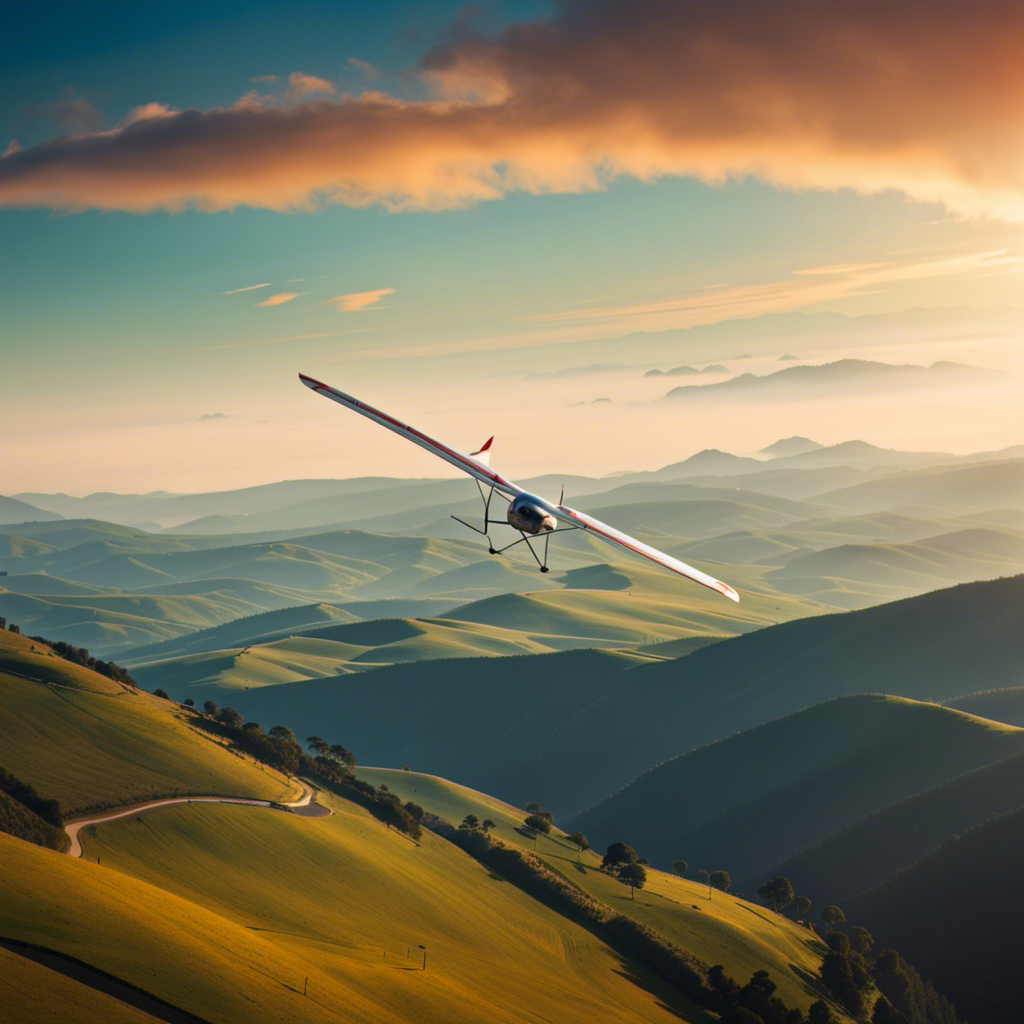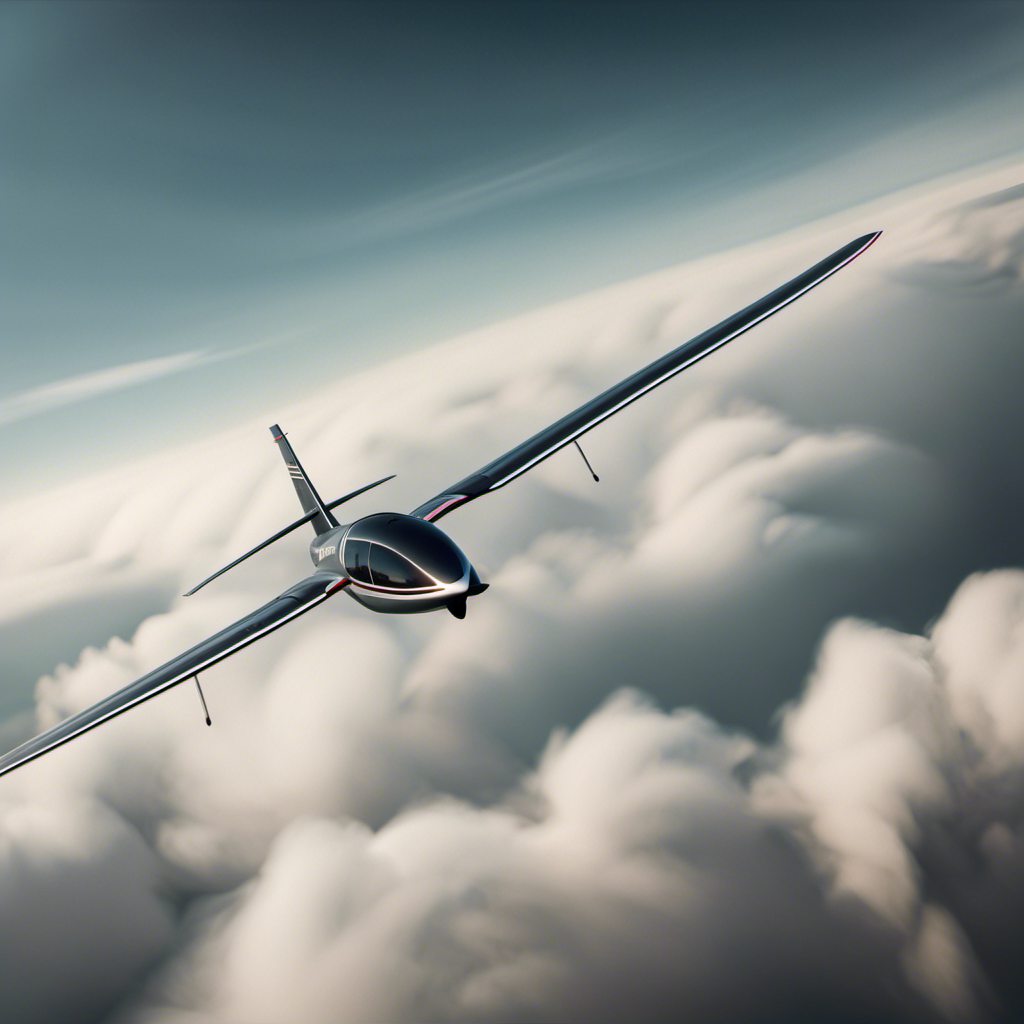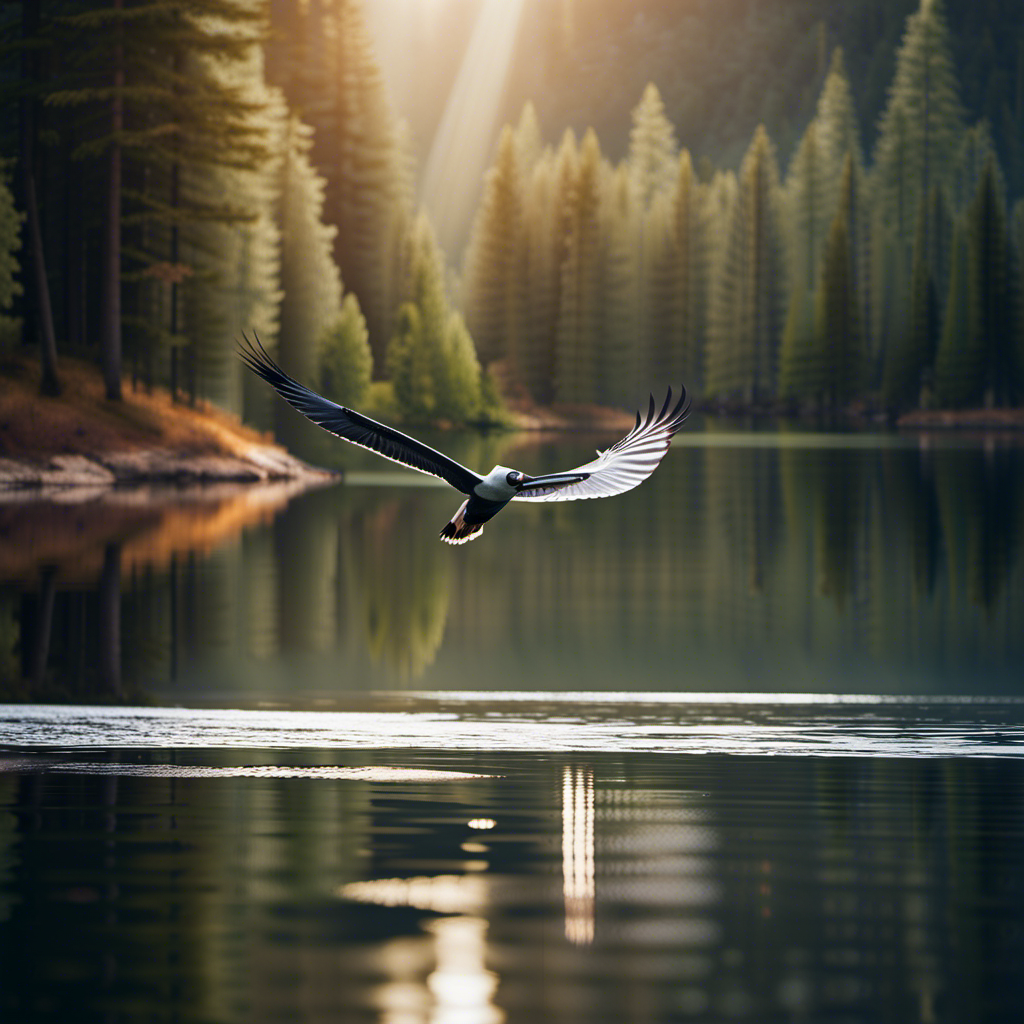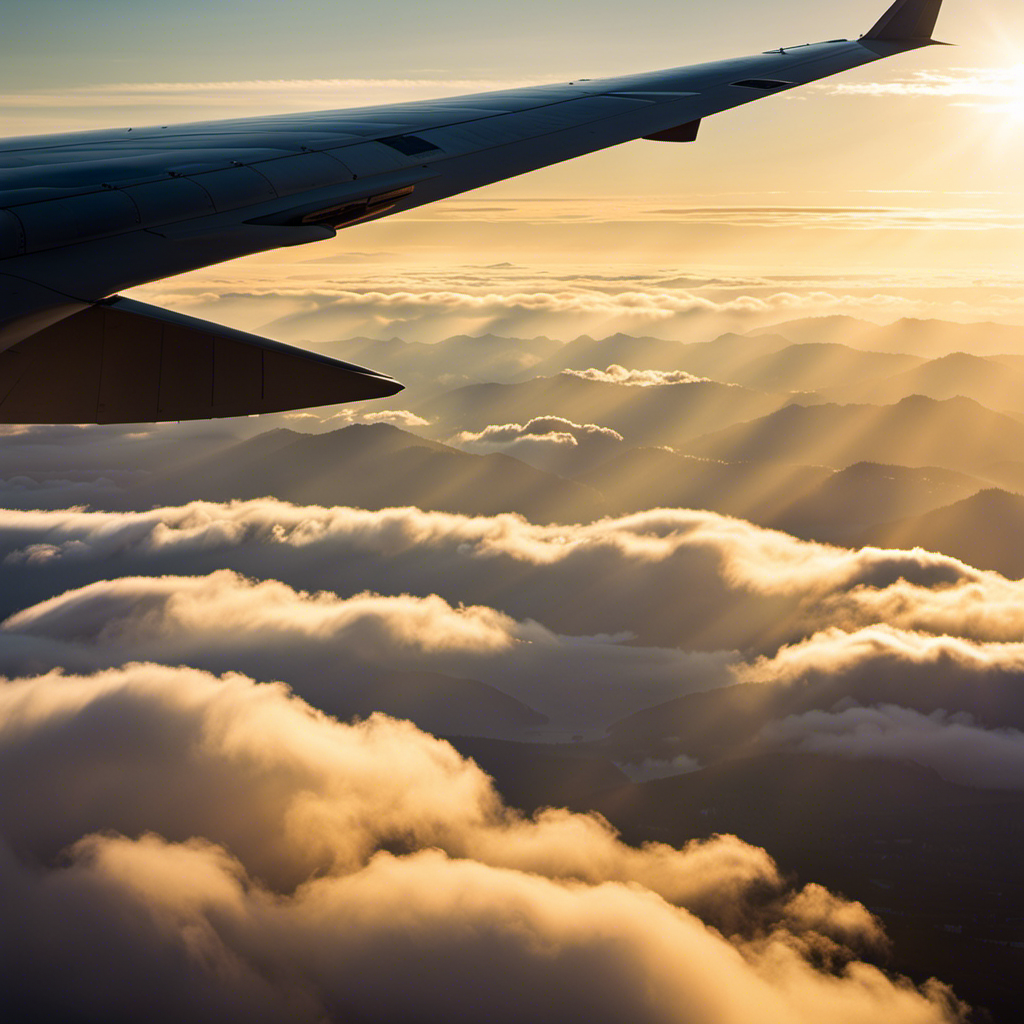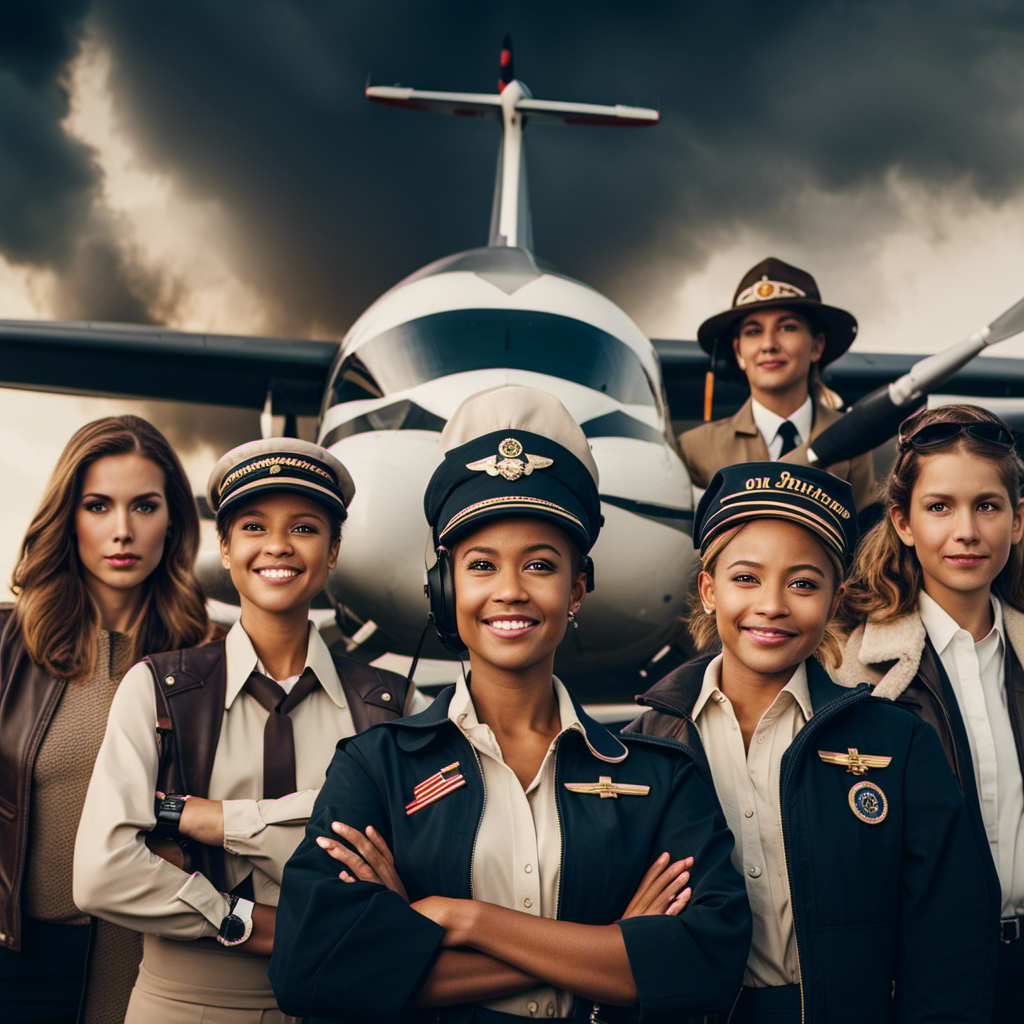As I soar through the vast sky, I am captivated by the immense possibilities of gliding in the air.
In this article, we will delve into the intricate mechanics of exploring the range of a glider, focusing on the crucial factors that influence distance and duration.
Prepare to be immersed in a technical and analytical journey as we unravel the secrets behind glider endurance, examine remarkable world records, and discuss the future of this exhilarating form of exploration.
Get ready to embark on a thrilling adventure through the skies!
Key Takeaways
- Lift generated by wing shape and air movement is crucial for glider flight.
- Factors such as wind speed, air temperature, altitude, glider design, and pilot skill affect the range of a glider.
- Glider endurance and efficiency depend on aerodynamic design, weight, and weather conditions.
- Notable glider flights and records demonstrate the potential for long distances and durations in glider flight.
Basic Principles of Glider Flight
The basic principles of glider flight include how lift is generated and how the glider can stay airborne without an engine. Glider aerodynamics plays a crucial role in understanding these principles.
Lift is the force that opposes gravity and keeps the glider in the air. It is generated by the shape of the wings and the movement of air over them. As the glider moves forward, the air flows faster over the curved top surface of the wings, creating lower pressure. This pressure difference between the top and bottom surfaces generates lift.
However, lift is not the only force acting on the glider. Drag, which is caused by air resistance, opposes the forward motion of the glider. It is essential to minimize drag to maximize the glider’s efficiency and range. By maintaining a streamlined shape and reducing unnecessary protrusions, drag can be minimized.
Understanding the interplay between lift and drag is fundamental to glider flight.
Transitioning into the subsequent section about factors affecting glider range, it is crucial to consider various aspects such as weather conditions, pilot skill, and weight distribution.
Factors Affecting Glider Range
Factors like wind speed and air temperature can directly impact the range of a glider. Understanding these factors is crucial for maximizing glider endurance.
Here are some key factors that can affect the range of a glider:
-
Wind speed: The speed and direction of the wind can greatly influence the distance a glider can travel. A headwind can slow down the glider and reduce its range, while a tailwind can provide a boost and increase the range.
-
Air temperature: Temperature affects the air density, which in turn affects the glider’s lift. Warmer air is less dense, resulting in less lift and shorter glider range. Cooler air, on the other hand, is denser and can provide more lift, allowing the glider to travel further.
-
Altitude: The altitude at which the glider is flying also plays a role in its range. Higher altitudes generally have thinner air, which can reduce the glider’s lift and limit its range.
-
Glider design: The design and performance characteristics of the glider itself can impact its range. Factors such as wing shape, aspect ratio, and glider weight all contribute to the glider’s efficiency and ultimately affect its range.
-
Pilot skill: The skill and experience of the pilot can also affect the glider’s range. A skilled pilot can make better decisions, find optimal conditions, and utilize various techniques to maximize the glider’s endurance.
Understanding these factors is essential for planning and executing a successful glider flight. By taking these factors into account, pilots can optimize their glider’s range and achieve greater endurance without compromising safety or performance.
Understanding Glider Endurance
To maximize your glider’s endurance, it’s important to understand how various factors can impact its range. Glider efficiency plays a crucial role in determining how far and how long your glider can fly. There are several key factors that affect glider endurance.
One of the main factors is the glider’s aerodynamic design. A well-designed glider with low drag will have better efficiency and, therefore, longer endurance. The shape of the wings, the smoothness of the surfaces, and the overall sleekness of the glider all contribute to reducing drag and increasing endurance.
Another important factor is the weight of the glider. A lighter glider will require less energy to stay aloft and can therefore fly for longer periods. This is why gliders are typically made of lightweight materials such as carbon fiber and fiberglass.
The weather conditions also play a significant role in glider endurance. Factors such as wind speed and direction, thermals, and atmospheric stability can greatly affect the glider’s ability to stay aloft. Understanding these weather patterns and using them to your advantage can help maximize your glider’s endurance.
In conclusion, glider efficiency and various endurance factors such as aerodynamic design, weight, and weather conditions all contribute to determining the range and duration of a glider’s flight. By understanding and optimizing these factors, you can maximize your glider’s endurance and achieve longer flights.
Transitioning into the subsequent section about the ‘longest glider flights in history,’ it’s fascinating to explore the remarkable achievements of pilots who have pushed the boundaries of glider endurance.
Longest Glider Flights in History
If you’re interested in record-breaking achievements, you’ll be amazed by the pilots who have shattered glider endurance records. These remarkable individuals have pushed the boundaries of what is possible in the world of gliding, demonstrating the incredible potential for prolonged flight.
Here are four astonishing examples of the longest glider flights in history:
-
Steve Fossett: In 2006, Fossett completed a solo flight that lasted an astonishing 76 hours and 45 minutes. This remarkable feat took him across the United States, covering a distance of 2,714 miles.
-
Klaus Ohlmann: Ohlmann holds the record for the longest out-and-return glider flight, covering a distance of 1,463 miles. This incredible achievement took place in 2003, as Ohlmann soared through the skies of Argentina.
-
Emanuel Koepp: Koepp set the record for the longest triangle flight in 2012, covering a distance of 1,311 miles. This impressive journey took him across the landscapes of Australia, showcasing the endurance of both pilot and glider.
-
Sarah Arnold: Arnold achieved the longest female solo glider flight in 2019, flying for an impressive 13 hours and 39 minutes. This remarkable accomplishment demonstrated the determination and skill of female glider pilots.
These record-breaking flights highlight the immense capability and endurance of gliders. Planning a cross-country glider flight requires meticulous attention to detail and careful consideration of various factors.
Planning a Cross-Country Glider Flight
When planning a cross-country glider flight, there are several key points that need to be considered.
Route selection and navigation involve carefully analyzing weather patterns, terrain features, and airspace restrictions to determine the most efficient and safe path for the flight.
Safety considerations encompass factors such as pre-flight inspections, proper equipment, and communication protocols, ensuring that the flight is conducted with the highest level of safety.
Lastly, emergency procedures outline the necessary actions to be taken in the event of an unexpected situation or equipment failure, emphasizing the importance of quick thinking and preparedness during the flight.
Route Selection and Navigation
Choosing the right route and navigating effectively are key to maximizing the distance and duration of a glider flight. Route planning involves considering various factors, such as wind direction, thermals, and geographic features.
Weather forecasting plays a crucial role in determining the best route options. Here are three important considerations for route selection and navigation:
-
Analyze wind patterns: Understanding the prevailing winds and how they interact with the landscape can help identify areas with favorable lift conditions, such as ridge soaring or thermals.
-
Evaluate topography: Identifying geographic features like mountains, valleys, and lakes can provide clues about potential sources of lift or areas to avoid due to turbulence or wind shadows.
-
Consider airspace restrictions: Checking airspace charts and understanding the regulations is vital for planning a safe and legal flight path.
By carefully considering these factors during route planning and effectively navigating during the flight, glider pilots can optimize their distance and duration.
However, it’s important to also take into account safety considerations and emergency procedures to ensure a successful and secure flight.
Safety Considerations and Emergency Procedures
To ensure a safe and secure flight, it’s crucial that you familiarize yourself with safety considerations and emergency procedures. Understanding and following proper safety procedures is essential in mitigating risks and ensuring the well-being of all onboard. In the event of an emergency, quick and efficient emergency response is vital. Below, I have provided a table outlining some key safety considerations and emergency procedures that every pilot should be aware of:
| Safety Considerations | Emergency Procedures |
|---|---|
| Pre-flight inspection | Engine failure |
| Seatbelt usage | Fire onboard |
| Emergency exits | Loss of control |
| Communication protocols | Emergency landing |
| Weather monitoring | Medical emergencies |
Glider Range vs. Powered Aircraft Range
The glider’s range is significantly shorter than that of powered aircraft. When comparing the range of gliders to powered aircraft, it is important to understand the limitations of gliders in terms of distance and duration. Gliders rely solely on atmospheric conditions, such as thermals and ridge lift, to stay aloft. This means that they can only travel as far as the availability of these natural sources of lift allows. Powered aircraft, on the other hand, have engines that enable them to travel much longer distances and at higher speeds.
Glider range is typically measured in terms of distance covered or duration of flight. While there are exceptions, most gliders have a range of around 300 to 500 kilometers or 3 to 6 hours of flight time. This is significantly shorter than the range of powered aircraft, which can travel thousands of kilometers without the need for additional lift sources.
The limited range of gliders is primarily due to their lack of engine power. Without an engine, gliders cannot generate their own lift and are reliant on external sources. This makes them more suitable for local flights or shorter cross-country journeys rather than long-distance travel.
In conclusion, when comparing the range of gliders to powered aircraft, it is evident that gliders have a significantly shorter range. While gliders offer a unique and thrilling flying experience, their limited range restricts their use for longer expeditions.
Transitioning into the subsequent section about notable glider expedition stories, it is fascinating to explore the various achievements and challenges faced by glider pilots in their quest for long-distance exploration.
Notable Glider Expedition Stories
One fascinating glider expedition story is that of Charles Lindbergh, who became the first person to fly solo across the Atlantic Ocean in 1927. It was an incredible feat of endurance and skill, as Lindbergh navigated his glider, the Spirit of St. Louis, for over 3,600 miles from New York to Paris.
This notable glider expedition inspired many other famous glider pilots to embark on similar adventures. Some other notable glider expeditions include:
-
Amelia Earhart’s solo flight across the Pacific Ocean in 1935, covering a distance of 2,408 miles from Hawaii to California.
-
Steve Fossett’s record-breaking non-stop flight around the world in 2006, covering a distance of 25,000 miles in 76 hours.
-
Klaus Ohlmann’s high-altitude glider flights, reaching heights of over 50,000 feet and exploring the limits of glider performance.
These expeditions demonstrate the incredible capabilities of gliders and the skill of the pilots who fly them. They push the boundaries of what is possible in terms of distance and duration, showcasing the potential of gliders as a means of exploration and adventure.
In the subsequent section about glider range and duration world records, we will delve deeper into the specific achievements and advancements in this area.
Glider Range and Duration World Records
If you want to learn about glider range and duration world records, you’ll be amazed by the incredible achievements and advancements in this area. Glider range competitions push the limits of endurance and distance, showcasing the technical prowess and strategies employed by pilots. These competitions require meticulous planning, precise calculations, and the implementation of various glider endurance techniques.
To achieve remarkable glider range and duration records, pilots employ a combination of tactics. One technique is maximizing altitude gain through thermals or ridge lift, allowing the glider to remain in flight for extended periods. Pilots also utilize efficient glider design and construction, reducing drag and increasing glide ratio. Additionally, strategic route planning and navigation play a crucial role in optimizing glider range and duration.
Advancements in glider technology have further enhanced the potential for achieving remarkable range and duration records. Improved aerodynamics, lighter materials, and advanced instrumentation have all contributed to more efficient gliders. These advancements allow pilots to push the boundaries of what is possible, reaching new heights in glider range and duration.
Transitioning to the subsequent section about advancements in glider technology, it is fascinating to explore how these innovations have revolutionized the field and opened up new possibilities for glider pilots.
Advancements in Glider Technology
When discussing advancements in glider technology, two key areas that stand out are materials and construction, as well as instrumentation and avionics.
In terms of materials and construction, advancements in lightweight composites such as carbon fiber have allowed for stronger and more aerodynamically efficient glider structures. Additionally, innovative construction techniques such as the use of winglets and laminar flow wings have contributed to improved performance and increased glide ratios.
In terms of instrumentation and avionics, modern gliders are equipped with advanced navigation systems, altimeters, variometers, and even autopilot capabilities, all of which enhance pilot situational awareness and aid in optimizing flight performance.
Materials and Construction
The materials and construction of the glider greatly impact its range and performance. When it comes to materials selection, lightweight and durable options are essential. Carbon fiber composites are commonly used due to their high strength-to-weight ratio. These materials not only reduce the overall weight of the glider but also enhance its structural integrity.
Construction techniques play a vital role in optimizing the glider’s performance. Advanced manufacturing processes, such as resin infusion and automated layup, ensure precise and consistent fabrication. These techniques minimize weight variations and improve aerodynamic efficiency. Additionally, careful attention is given to the wing design and construction to maximize lift and minimize drag.
By employing effective materials selection and construction techniques, glider manufacturers can create aircraft with superior range and performance.
Moving forward, this discussion will delve into the role of instrumentation and avionics in enhancing glider capabilities.
Instrumentation and Avionics
Instrumentation and avionics play a crucial role in enhancing a glider’s capabilities by providing essential data and navigation assistance. The advancements in instrumentation technology and avionics have revolutionized the way glider pilots navigate and gather data during their flights.
Instrumentation technology has evolved to include sophisticated instruments such as altimeters, airspeed indicators, variometers, and GPS systems. These instruments provide real-time information about altitude, airspeed, rate of climb, and position, allowing pilots to make informed decisions and optimize their flight paths.
Avionics advancements have also improved communication capabilities, enabling glider pilots to stay connected with air traffic control and other pilots. The integration of these technologies has greatly increased the safety and efficiency of glider flights.
As we look towards the future of glider exploration, further advancements in instrumentation and avionics will continue to push the boundaries of what is possible in terms of distance and duration.
The Future of Glider Exploration
I can’t wait to see what the future holds for glider exploration. As technology continues to advance, there are exciting possibilities for future developments that will further enhance the capabilities of gliders. One area of focus is sustainable flying, aiming to reduce the environmental impact of glider operations.
| Future Developments | Sustainable Flying |
|---|---|
| Improved Materials | Electric Propulsion |
| Advanced Aerodynamics | Renewable Energy |
| Enhanced Navigation Systems | Efficient Energy Storage |
In terms of future developments, improved materials will play a crucial role. Lightweight and strong materials, such as carbon fiber composites, will allow for even lighter and more efficient gliders. This will enable longer distances and durations of flights.
Another key aspect of future glider exploration is sustainable flying. Electric propulsion systems are being developed, which will reduce the reliance on fossil fuels. Renewable energy sources, such as solar panels on the wings, can power the glider during flight. Additionally, efficient energy storage systems will allow for extended flight times without compromising performance.
Furthermore, advanced aerodynamics will contribute to increased efficiency. Streamlined designs and innovative wing shapes will reduce drag and optimize lift, allowing gliders to cover more ground with less energy.
Lastly, enhanced navigation systems will provide glider pilots with accurate real-time information, enabling them to make better decisions during their flights. This will include advanced GPS systems, weather monitoring, and airspace management tools.
Overall, the future of glider exploration looks promising with a focus on sustainable flying and advancements in materials, aerodynamics, and navigation systems. I am excited to witness the evolution of gliders and the incredible possibilities that lie ahead.
Frequently Asked Questions
What is the average cost of a glider and its maintenance?
The average cost of a glider, including its maintenance, can vary depending on the model and specific requirements. Maintenance costs typically include regular inspections, repairs, and replacement of parts, which can add up over time.
Can gliders be flown in bad weather conditions?
Glider safety precautions are crucial when considering the impact of weather on performance. Unfavorable conditions like high winds or storms can greatly affect a glider’s ability to fly safely and should be avoided.
How long does it take to become a certified glider pilot?
It typically takes several months to become a certified glider pilot. The training involves meeting certain requirements, such as completing a minimum number of flight hours, passing written exams, and demonstrating proficiency in various skills and maneuvers.
Are there any limitations on where gliders can fly?
Glider flight regulations dictate where gliders can fly and set altitude restrictions. These rules ensure the safety and order of the airspace. Compliance with these regulations is crucial for all glider pilots.
Are there any restrictions on carrying passengers in a glider?
There are restrictions on passenger carrying in gliders, as safety regulations must be followed. These regulations ensure that passengers are protected during flight and that the glider operates within its weight and balance limits.
Conclusion
In conclusion, the exploration of glider range and duration is a fascinating endeavor that pushes the boundaries of human flight.
By understanding the basic principles of glider flight and the factors that affect range and endurance, we can plan and execute remarkable cross-country expeditions.
The longest glider flights in history and the world records achieved in glider range and duration are testaments to human ingenuity and skill.
With advancements in glider technology, we can expect even greater achievements in the future.
So, buckle up and prepare for the thrilling future of glider exploration.
With a heart that soars as high as the skies, Aria, affectionately known as “Skylark,” is the driving force behind Soaring Skyways. Her journey into the gliding world began as a young dreamer gazing up at the soaring birds, yearning to experience the weightlessness and freedom they embodied. With years of experience both in the cockpit and behind the scenes, Aria’s commitment to the gliding community is unwavering.
